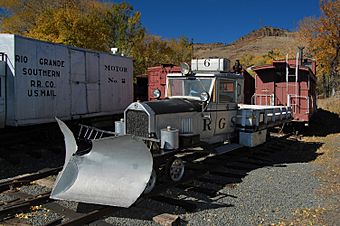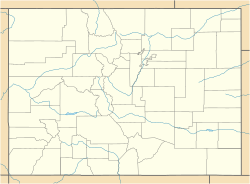Rio Grande Southern Railroad, Motor No. 6 facts for kids
|
Rio Grande Southern Railroad, Motor No. 6
|
|

Rio Grande Southern Railroad Galloping Goose 6, Colorado Railroad Museum, Golden, Colorado
|
|
| Nearest city | Golden, Colorado |
|---|---|
| Area | less than one acre |
| Built | 1942 |
| Built by | Odenbaugh, Jack; White, Forest |
| Architectural style | narrow gauge RR cars |
| NRHP reference No. | 97000050 |
Quick facts for kids Significant dates |
|
| Added to NRHP | February 19, 1997 |
The Rio Grande Southern Railroad (RGS) Motor Number 6 is a special train car. People often call it "Galloping Goose Number 6." It runs on a gasoline engine, much like a car. This unique vehicle was built using parts from a Buick automobile.
The front part of the Buick car body was kept. The back part was cut off, and a new wall was added. The steering wheel was removed because it wasn't needed for a train. However, other controls stayed in place. The car's front axle was replaced with a special train wheel setup. This setup had two axles and small wheels, which helped guide the Goose on the tracks.
At the very front of the Goose, there's a "cow catcher." This part helps clear small objects from the tracks. There are also small scrapers that slide along the rails. These scrapers prevent tiny things from making the lightweight front wheels jump off the track. In winter, a small snow plow could be attached to the front.
The back of the car was made longer with strong steel pieces. This created a flat platform, like a truck bed. It has short walls around the sides to keep things from falling off.
How the Galloping Goose Works
The Goose first used the engine, clutch, and transmission from the original Buick car. A chain system powered the rear wheels. This chain turned only the front axle of the rear wheel set. The very back axle was driven by other chains and sprockets. The rear wheels were larger, about 24 inches across.
Stopping the Goose
To stop the Goose, special brake pads push against the wheels. These pads are connected to the normal foot pedal and parking brake lever. The foot pedal controls the front brakes. The parking brake lever controls the rear brakes. Around 1939, Galloping Goose No. 6 also got air brakes, making it safer to stop.
What Color Was It?
The early paint colors of Goose No. 6 are still a mystery. Experts have looked at the layers of paint on the back platform. They found only black paint, and then aluminum paint used after 1935. This suggests it might have been black or aluminum for most of its life.
Changes Over Time
Around 1942, the Buick body on Goose No. 6 was replaced. A new body from a Pierce-Arrow car was used instead. The Buick engine was also swapped out for a Pierce-Arrow engine.
Soon after, a small box was added behind the back seat. This box was probably used to carry lunches or small tools. Around 1949, a second gas tank was put on the roof of the cab. This was in addition to the tank already under the front of the flatbed. Both tanks supplied fuel to the engine.
The car-style lights on the side of the cab were removed. Instead, train-style marker lights were placed on top of the cab, at the outer edges. This is how Galloping Goose No. 6 looks today at the Museum.



